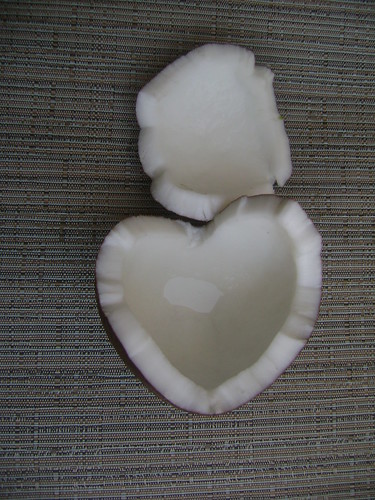Creamy Sandalwood

Driven in part by my disappointment from Santal Massoïa (too cold, linear and paper-like) I've decided to smell for myself what sandalwood and massoia bark smell like together. Intuition tells me it should be smelling creamy, rich, warm and seductive, and not like a glass of cold milk spiked with iso-E super.
Sandalwood is a tricky note for me: one that does not develop very nicely on my skin. That is to say, the sandalwoods that are available nowadays don't agree with my skin. Unless you're attracted to sawdust and soured sweat. So intuition told me that adding a creamy aspect to it, which is what most contemporary sandalwoods are lacking, is going to allow me to enjoy sandalwood even on my finicky skin.
Massoia bark oil and CO2 extract have a unique aroma in the world of natural essences: intense, fruity, fatty-buttery with pronounced oily, lactonic notes of toasted-coconuts that comes from massoia lactone (the IUPAC name is (R)-5,6-Dihydro-6-pentyl-2H-pyran-2-one). It also naturally occurs in osmanthus absolute, which is why in some combinations, and when used sparingly osmanthus gives off a coconutty aroma to a composition without even being noticed on its own. Case in point is my Charisma perfume, which took on this character only once I've added the osmanthus absolute.
Other milky notes were also taken into consideration, including a milky oolong tincture which I haven't used in any of my ready-to-wear line yet, although it is absolutely stunning. The idea was to create a very rich, opulent sandalwood perfume that is both sophisticated and a little beachy and fun-loving.
I used a smidgeon from a sample of Royal Hawaiian sandalwood oil I recently received, as well as my personal stash of Mysore sandalwood oil and Vanuatu oil (the latter is my favourite). Add to that a healthy dose of massoia bark, milky oolong tincture and a handful of secret spices - and you get the broad picture.
The next step was to balance it with something floral, so it's not just an accord of woods. I was on the fence between champaca's incense, fruity undertones; and ylang ylang's creamy, banana-ish character. Then there is the question of warmth and spices: shall I add cloves, cinnamon, allspice, or nutmeg? I wanted their warmth, but not the culinary associations. So I opted for coffee instead - to give it a roasted, spice-like edge, but not mess up with the woody-coconutty context. This perfume is still in the works, so I will stop right here and will continue testing and tweaking until I'm perfectly happy with it. For now, I'm just enjoying dousing myself with it on those early days of summer. And it's especially appropriate to wear today, as it is Shavuot!
P.s. It's interesting to note regarding Massoia: Massoia lactone is produced synthetically, mostly, for both perfumery and flavouring purposes. Peeling the bark eventually kills the tree, so it's not exactly a "sustainable" ingredient, even though a little goes a very long way...


